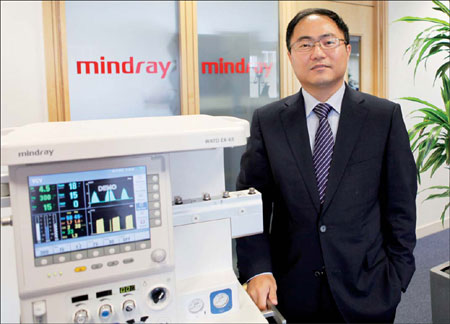Making up Mindray

| David Yin says Mindray is committed to international expansion, especially in the US and Europe. Cecily Liu / China Daily |
Chinese company achieves success at home and abroad through quality
A company's first international order is often planned and prepared for at great length. But David Yin, managing director of Mindray Medical's European operations, recalled that his team's first international order in 2000 was "an accident".
Mindray's "made in China" label attracted the attention of a British company during Medica, a trade fair held in Germany. The company took one of Mindray's products to be assessed at a British hospital, and made a purchase after receiving assurance of its quality.
More than a decade later, Mindray has grown into an international leader in the medical devices industry, exporting products to more than 190 countries and regions.
Its net revenue for the 2011 reached $880.7 million (680 million euros), of which $506.4 million was generated from overseas markets.
"We are committed to international expansion, especially in the US and Europe," says Yin. "These two markets are like two fortresses we have to conquer to become a truly global leader."
Mindray was founded in Shenzhen in 1991, originally as a trade company selling medical equipment produced by foreign companies in China.
But its co-founders Xu Hang and Li Xiting, who were engineers at a state-owned maker of medical instruments in the 1980s, had an ambition.
They wanted the company to one day produce its own medical equipment, so Mindray invested heavily in research and development and successfully came up with China's first patient-monitoring device in 1992.
In the late 90s Mindray realized that China's medical equipment market was limited compared with advanced economies like Europe and the US.
To prepare for international expansion, Mindray started to develop products to international regulatory standards.
Most of its products have the CE mark - which stands for the French "Conformite Europeenne" - that is mandatory for health, safety and environmental protection products sold in the European Union. Some of its products have received US Food and Drug Administration clearance.
Yin says the "accident" in 2000 was only made possible by this preparatory work.
"It demonstrated that we were ready for the foreign market."
In 2004 Mindray established an office in the US, and two years later in Britain. This network of subsidiaries and representative offices has since grown to cover about 20 countries, including France, Germany, the Netherlands and Spain.
Mindray was listed on the New York Stock Exchange in 2006, raising $311 million, the largest initial offering in the global healthcare industry over the previous two years. The publicity was an international boost for Mindray's brand.
Despite having to compete head to head with international giants such as Philips Healthcare, GE Healthcare and Spacelabs, Mindray has secured many high-profile projects over the years.
One of them is to supply medical equipment to Britain's public healthcare system, the National Health Service, including patient devices, equipment and ultrasound machines.
"We entered talks with the NHS around 2006-07, and they had an open attitude about our products," Yin says.
In 2008 Mindray placed a bid to enter the NHS's procurement system. "We were assessed as a business holistically, including our product quality, commercial qualification and after-sales service. We passed the test and have remained in their procurement system ever since."
Yin says that Mindray's key advantage in Europe is not its price, but its product quality and after sales services.
"Most hospitals have a procurement process whereby prices are not made known at first," Yin says.
For example, the hospital could ask each bidder to send their products to the hospital for one month, during which a technical assistant and an after-sales assistant would be required to stay and teach the doctors how to use the devices.
"The doctors then rate the equipment. So if six companies enter the first round, only the most highly rated two or three bidders are then given the opportunity to tell the procurement department their product prices," Yin says.
"That is why we place great emphasis on product quality and innovation."
According to Mindray's website, it invests about 10 percent of its annual revenue in R&D, and has introduced about eight new products to the market in each of the past seven years.
The company has about 1,550 R&D employees, accounting for about a third of its workforce.
One milestone for Mindray's overseas expansion was its $200 million acquisition of New Jersey-based Datascope's patient monitoring business in 2008, which turned the company into the third-largest player in the global patient monitoring device industry.
Datascope's R&D center in Stockholm, Sweden, became a valuable asset to Mindray. The deal also gave Mindray a direct sales force in Europe and North America, as it was selling through distributors before the acquisition.
"We were able to achieve great synergy in with Datascope in Europe," Yin says, explaining that the two companies have complementary expertise in R&D work and market knowledge.
"Datascope has been in contact with European customers for decades, so they understand the customers' needs. But they couldn't deliver the products needed due to high R&D cost but slow speed," he says.
"Mindray's advantage is the ability to turn R&D results into actual products. For example, if Datascope needs five years to develop a product, Mindray only needs two years to develop the same product."
After the acquisition, Mindray sent some R&D staff from Shenzhen to visit European clients through Datascope's existing connections. "Datascope's channels function as an introduction, through which our R&D team learnt more about customer needs," he explained.
But one challenge Mindray still faces is overcoming prejudices about the quality of Chinese products.
"This is particularly a challenge when it comes to customers in developed markets like Europe and the US," Yin says.
"We have to continuously explain to them that Chinese products are not just cheap exports, because China has many high-tech companies, many highly skilled employees, and many companies that understand clients' needs and are keen to solve clients' problems."
The quality of Mindray's products has won the trust of its customers, but Yin says that he hopes more high-tech Chinese products can find success in Europe.
Meanwhile, Mindray has strengthened its presence in developing markets through price advantage, so to put "healthcare within reach", as the company slogan says.
Mindray's ability to understand the needs of developing countries' customers is a crucial message in Yin's speech at last month's World Medtech Forum Lucerne, in Switzerland.
"Many European or North American medical devices companies are talking about the whole market shrinking, but the reality is that only 1 billion out of 7 billion people globally live in developed countries. To offer affordable products for the remaining 6 billion people is Mindray's advantage," he explained.
Mindray's expansion into the European market is similar to many privately-owned Chinese businesses that are motivated to expand overseas by commercial opportunities as well as Chinese government policy initiatives.
For example, the government encouraged privately owned businesses to expand internationally in its 12th Five-Year Plan (2011-15).
Yin said that he is glad that Mindray has received great support from the Chinese government over the years, particularly in intellectual property rights protection.
"IPR is a key asset for high-tech companies like Mindray. We have noticed that China's patent laws have become much more complete and their enforcement much more stringent over the past decade," he says.
Mindray applied for its first patent in 1997. To date it has received over 1,000 patents, of which over 200 are overseas patents, Yin says.
"Back in the days when IPR enforcement was poor, no Chinese company dared to invest in R&D, but now many Chinese companies invest heavily in R&D.
"With great support from home, we are committed to invest globally, and we hope our success will improve the image of Chinese products in Europe and beyond."
cecily.liu@chinadaily.com.cn
(China Daily 11/30/2012 page22)
Today's Top News
- Xi stresses improving long-term mechanisms for cyberspace governance
- Experts share ideas on advancing human rights
- Japan PM's remarks on Taiwan send severely wrong signal
- Key steps to boost RMB's intl standing highlighted
- Sustained fight against corruption urged
- Xi calls for promotion of spirit of volunteerism































